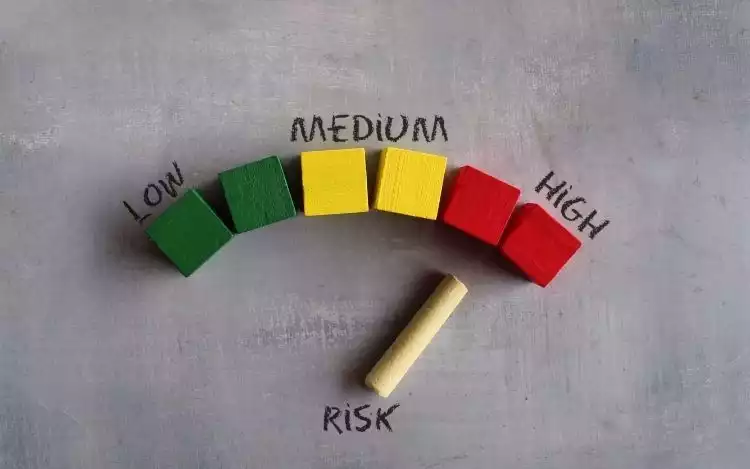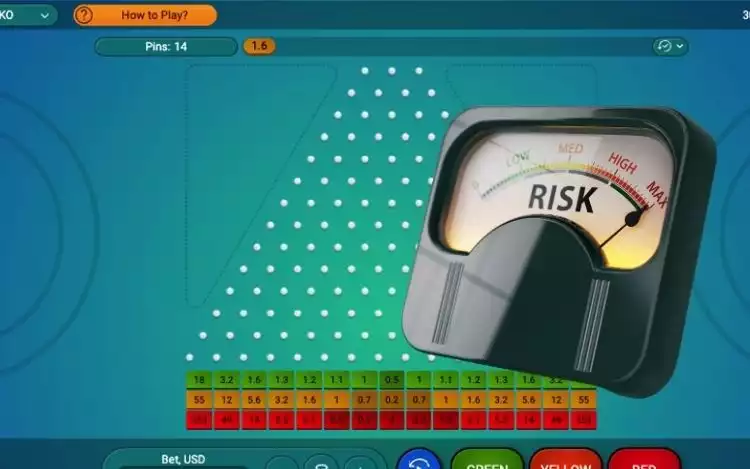Plinko looks innocent. Drop a ball, watch it bounce around, and hope it lands somewhere good. But there is a catch here. Before you even drop that ball, you must pick your risk level. And that choice decides whether your game feels like a Sunday stroll or a tightrope walk over fire.
How Risk Levels Work in Plinko
Every Plinko game is built on the same grid: pegs scatter the ball’s path until it drops into a slot with a payout multiplier. The multipliers change based on your chosen risk.
- Low Risk: Safer, with smaller multipliers but fewer brutal losses.
- Medium Risk: Balanced payouts, a bit of danger mixed with steady wins.
- High Risk: Big multipliers at the edges, but far more chance of losing your stake.
Keep in mind that the game does not change mechanically. The ball still bounces randomly. But the numbers at the bottom do.
Let us take a look at each of the three levels.
Low-Risk Plinko: Safe but Modest
Low risk is like training wheels. Multipliers usually range from 0.5x to 10x. Most balls land somewhere close to your bet, sometimes slightly less, sometimes slightly more.
- Best for: Casual players who want longer sessions without draining their balance.
- Downside: You will not hit life-changing wins here.
It is essentially Plinko for people who like to walk away with most of what they came in with.
Medium-Risk Plinko: Balanced Play
Medium risk is where many players land. The multipliers stretch higher (often up to 25x or so) but still keep plenty of slots near your original bet value.
- Best for: Players who want a shot at excitement without going full kamikaze.
- Downside: You will lose a bit more often than low-risk mode, but wins feel more satisfying.
It is the “just spicy enough” setting on the menu. You want something more than regular Plinko? Want to up the game a bit? Want to get a feel for what slightly more risk could look like? Great, go medium risk.
High-Risk Plinko: All or Nothing

High-Risk Plinko All or Nothing
High risk is where the adrenaline lives. Multipliers can rocket up into the hundreds or even thousands. But most of the slots are punishingly low, sometimes even zero.
- Best for: Players chasing big, rare payouts.
- Downside: Balance drains fast if you are unlucky, which you will be more often than not.
High-risk Plinko is basically a lottery disguised as a ball-drop game. Fun if you are chasing thrills, dangerous if you are chasing profit.
So, how do you pick the right risk for yourself? The best way is to ask yourself what you want out of Plinko.
- Do you want steady entertainment? Go low risk.
- Do you want a balance between excitement and caution? Medium risk is your friend.
- Do you want big multipliers and do not mind burning through bankroll fast? High risk will scratch that itch.
The key is to never confuse “high risk” with “smart play.” Big multipliers look tempting, but they are rare for a reason.
How Row Size Affects Risk Levels in Plinko
Risk level is just one part of the equation in Plinko. The other? Row size. The number of rows (or pegs) changes how far the ball can bounce before landing: and that has a direct effect on how often you hit those juicy multipliers.
Most Plinko games let you choose anywhere from 8 rows up to 16 or even more. Most Plinko gambling sites will not clarify how this all works, so here is a summary of what all this means in practice:
Fewer Rows = Simpler, Safer
With fewer rows, the ball has fewer opportunities to bounce unpredictably. It tends to stay closer to the centre. That means:
- You will see more consistent results.
- Extreme outcomes (like the highest multipliers) are harder to hit.
- Combined with low risk, this is as close as Plinko gets to a chill mode.
More Rows = Wild Variance
Add more rows and suddenly the ball has more chances to bounce off course. That increases the spread of outcomes. In other words:
- High multipliers at the edges become more realistic.
- So do brutal losses.
- Medium results appear less often than with smaller grids.
Now imagine this with high-risk mode. You have essentially turned Plinko into a cliff jump. You might land a 1,000x multiplier. Or you might hit the rocks.
Risk + Rows: How They Interact
Here is a quick summary how risk and rows interact in Plinko:
- Low risk + few rows: Very steady, modest returns. Great for cautious players.
- Low risk + many rows: Still relatively safe, but adds a touch of unpredictability.
- High risk + few rows: Thrilling, but slightly more forgiving because the ball has less room to wander.
- High risk + many rows: Maximum volatility. Big jackpots are possible, but bankrolls vanish in minutes if you are unlucky. Not recommended for beginners at all.
Rows change how the game feels as much as how it plays. With fewer rows, the ball drops quickly and you get results fast. More rows slow things down, add suspense, and make every bounce feel like a heart attack. Developers know this: longer falls keep players glued to the screen.
If you are experimenting with Plinko, start small. Try medium risk with 12 rows. It gives you a balanced feel for variance without emptying your account in ten seconds. Once you understand how the ball tends to move, you can crank up the rows or risk if you are chasing entertainment.
|
Rows |
Low Risk |
Medium Risk |
High Risk |
|
8 Rows |
Steady, small wins. Very safe, little excitement. |
Balanced, but still predictable. Multipliers rarely exceed 5 to 10x. |
Thrilling, but the ball has less distance to drift. Slightly more forgiving. |
|
12 Rows |
Safe, with more variety. Occasional mid-level multipliers. |
Good balance of safety and excitement. A common sweet spot for most players. |
High volatility begins to show. Edges feel further away but more rewarding. |
|
16 Rows |
Still safe, but longer ball paths mean more suspense. |
Noticeable swings. You will hit more mid-tier multipliers than with fewer rows. |
Maximum volatility. Extreme multipliers are possible, but expect plenty of 0.5x results. |
In other words, fewer rows mean quicker results, tighter outcomes, and lower variance. More rows mean slower drops, wider spread of outcomes, and bigger swings. If you combine high risk and many rows, then you get the most volatile combination. This setting is great for thrill-seekers, not for cautious bankroll managers.
Let us say you play 12 rows, medium risk. Most of your drops will land near 0.5x to 5x, with the occasional 10x. Switch that same setup to 16 rows, high risk, and suddenly you are eyeing multipliers over 100x. But most balls will sink into 0.2x or 0.5x slots.
Same game, very different experience. Always play responsibly and with only what you can afford to lose.
FAQs on Plinko Risk Levels
Do risk levels change the ball’s path?
No. The ball always falls randomly. Risk levels only change the payout multipliers at the bottom of the board.
Which Plinko risk level is best?
It depends on your goals. Low risk is best for longevity, medium for balance, high for thrill-seeking.
Can I win big on low-risk Plinko?
Unlikely. Low-risk settings cap multipliers at smaller numbers. They are designed for safety, not jackpots.
Is high-risk Plinko worth it?
Only if you accept that most of your bets will lose. It is entertainment, not a long-term winning strategy.







